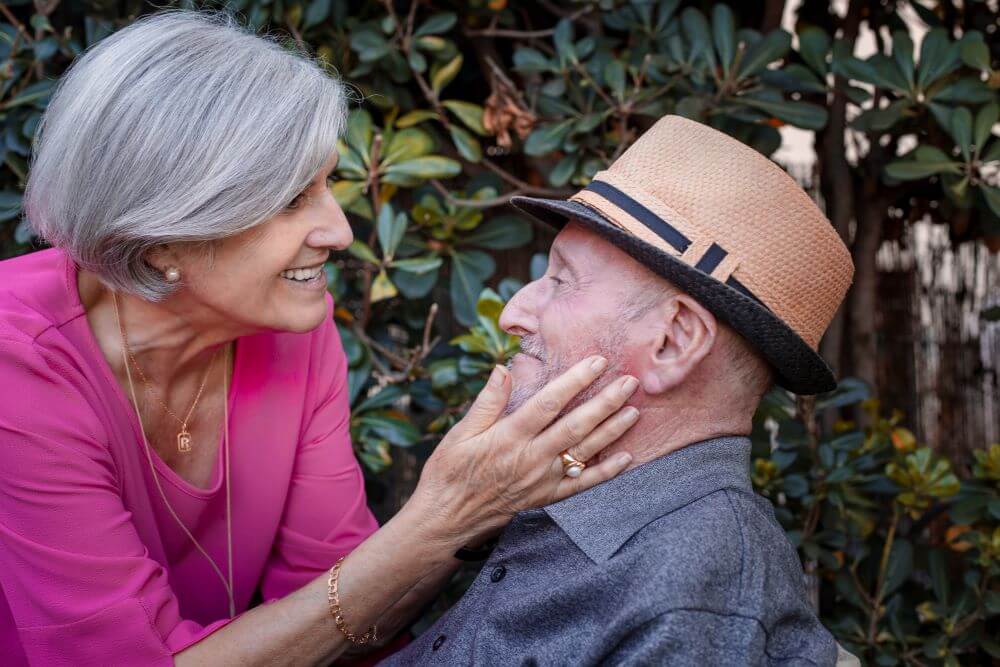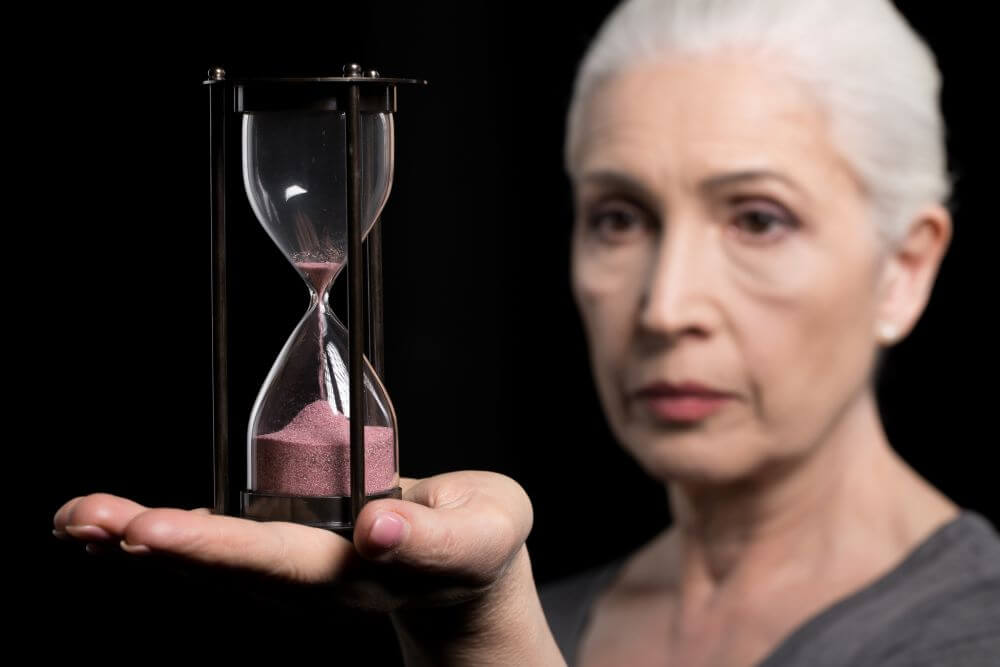Imagine taking a trip through time, not in a fancy machine, but within the labyrinth of the mind. That’s what living with dementia can feel like. For those unfamiliar, dementia is like a tricky puzzle, affecting memory in ways that might seem perplexing. It’s as if our loved ones with dementia are time travelers, moving between past and present, struggling to recognize the faces and moments that are part of their lives.

The Dementia Memory Time Travel Journey:
In the world of dementia, memories play hide-and-seek. New memories slip through the fingers like sand, while the old ones stand tall, vivid, and clear.
It’s like having a treasure trove of stories from yesteryears but struggling to remember what happened just yesterday. This memory maze can lead to a situation where a spouse or child may not be recognized because the person with dementia sees them as they were in the past.
It’s important to understand that this isn’t intentional. Dementia is like a gentle thief, taking away recent memories while leaving the cherished ones from long ago untouched. So, when Grandma looks at you and sees a much younger version, it’s not because she doesn’t know you—it’s because her mind is on a journey through the decades.

Unraveling the Threads of Time
Fading Footprints of Recent Memories:
Imagine walking through the sands of time, each step leaving a footprint that may slowly fade away. In the world of dementia, this is the reality of the memory journey. Recent memories become delicate footprints, easily washed away by the waves of forgetfulness. Names faces, and recent events may slip through the fingers like grains of sand, leaving caregivers and loved ones navigating a shifting landscape.
The Return to Childhood:
As the disease progresses, the journey takes a fascinating turn. It’s as if time itself reverses, and those living with dementia find themselves retracing the steps of their youth. This is where the essence of childhood memories takes center stage. Like a magical time machine, the mind transports individuals back to a time when the world was simpler, and innocence reigned.
Seeking Parents and the School Days Revisited:
One poignant aspect of this reversal is the inclination to seek parents or return to the comfort of the family home. It’s not uncommon for someone with dementia to express a desire to go home, even if they are in the place they’ve lived for years.
In their journey through time, the notion of home often becomes anchored in the warmth and security of childhood.
Another remarkable phenomenon is the rekindling of school memories. Individuals may believe they must go to school and express concern about being late for class. This intricate blend of past and present creates a unique narrative where the lines between reality and memory blur.
The Childlike Persona:
Picture a grandparent becoming more childlike, finding joy in simple pleasures, and expressing curiosity like a wide-eyed youngster. This transformation is a testament to the power of older memories taking center stage. The complexities of adulthood fade away, replaced by the innocence and wonder of childhood.
The Caregiver’s Role in the Childlike Journey:
As a caregiver, embracing the childlike persona becomes a key aspect of the journey. Imagine navigating the challenges of caregiving while understanding the delicate balance between providing care and fostering an environment where the individual feels safe to express their childlike nature.
Creating Moments of Joy:
Amidst the challenges, there’s an opportunity to create moments of joy. Engaging in activities that evoke the simplicity of childhood—whether it’s enjoying favorite childhood snacks, playing music from their youth, or sharing stories from the past—can become a bridge to connect with the childlike spirit within. “Creating Memories of Joy” by Jolene Brackey is one of the best books to help you understand how important and easy it is to create those moments of joy.

Navigating the Present: Practical Strategies for Identifying Dementia Time Travel
Gentle Questions About Age:
One effective way to understand the time frame someone with dementia is experiencing is through gentle questions about their age. Asking, “Can you tell me how old you are?” or “What year is it for you right now?” or “Who is the president?” can provide insights into their current perception of time. This simple act helps caregivers align their communication with the individual’s reality and bridge the gap between past and present.
Exploring Past Memories:
Engaging in conversations about their past can be like turning the pages of a cherished photo album. Asking open-ended questions (questions that are not answered by yes or no) about childhood, early adulthood, or significant life events can guide the individual back to specific moments in time. This helps caregivers understand their perspective and allows for meaningful connections through shared memories.
Examples of open-ended questions:
“Tell me about a favorite memory from your childhood. What stands out the most?”
It encourages the person to reminisce about positive experiences and provides an opportunity to connect through shared memories.
“Can you share a story about a special friend or family member that meant a lot to you?”
Invites the person to reflect on relationships, fostering a sense of connection and allowing for a more personalized conversation.
“What activities or hobbies did you enjoy when you were younger? Do you have any favorites that you still enjoy today?”
It encourages the person to recall past interests and may provide insight into activities that bring them joy in the present.
“If you could go anywhere in the world, where would it be, and what would you do there?”
Allows the individual to express their desires and dreams, tapping into their imagination and providing a window into their current thoughts.
“What was a typical day like for you when you were growing up? Can you describe your routine or favorite activities?”
Encourages the person to walk down memory lane, providing details about their daily life and allowing for a deeper understanding of their past.
Observing Surroundings and Clues for Dementia Time Travel:
The environment often holds clues to the perceived time frame of someone with dementia. Take note of the items around them, such as familiar objects, clothing, or decorations. These visual cues can offer valuable hints about the era they believe they are in, enabling caregivers to tailor their interactions accordingly.
Utilizing Memory Aids:
Incorporating memory aids, such as calendars, clocks, or memory boards, can serve as visual anchors for individuals with dementia. There are several dementia clocks on the market; you can find the one we use HERE.
These tools provide a tangible reference point, helping them orient themselves to the present moment. Caregivers can use these aids as gentle reminders of the current date, day, or time of day.
Establishing Routine and Predictability:
Routine provides a sense of stability and predictability for individuals with dementia. Establishing a consistent daily schedule can help ground them in the present. Simple routines, like meals at specific times or engaging in familiar activities, create a rhythm that contributes to a more secure and structured environment. Learn more bout the importance of routine HERE.
Collaborating with Healthcare Professionals:
Balancing these roles becomes more effective with insights into the progression of the disease. Collaborating with healthcare professionals, such as dementia specialists and physicians, becomes crucial. Alzlog, a system designed for tracking the progression of Alzheimer’s and related dementias, can provide valuable information. Regular check-ins and assessments, facilitated by Alzlog, offer a comprehensive view of cognitive changes.
Empathy and Validation:
Above all, approach the journey with empathy and validation. Acknowledge and validate the individual’s feelings and perceptions, even if they differ from the current reality. Creating a supportive and understanding atmosphere fosters trust and connection, making it easier to navigate the complexities of time within the world of dementia.
Find Peace Amidst the Storm!
Dementia caregiving can be overwhelming, but it doesn’t have to be. Say goodbye to the confusion and chaos.
Alzlog: The Caregivers Notebook can help you find the confidence, organization, and control you’ve been searching for.
Take the first step towards transformation now.


Dementia’s Time Travel and Effect on Relationships:
Now, let’s talk about the impact on relationships. Picture this: you’ve been caring for someone for years, sharing countless moments, and suddenly, they don’t recognize you. It can be heart-wrenching. But here’s the thing—it’s not about forgetting you; it’s about the time travel their mind is on.
Think of it as meeting an old friend after many years. You might recognize them, but there’s a moment of hesitation. For those with dementia, this happens not just with friends but with the closest family members, too. As caregivers, this can be tough emotionally, but understanding the nature of this journey can make the ride a bit smoother.

The Uncharted Territory of Recognition:
Imagine a loving couple who have weathered life’s storms together. They’ve shared laughter, tears, and countless cherished moments. Now, dementia has entered their lives, transforming the familiar landscape into uncharted territory. The husband, let’s call him Mr. Johnson, finds himself in a reality where recognition becomes elusive.
The Changing Face of Familiarity:
One day, Mrs. Johnson, his devoted wife, notices a subtle shift. Her husband looks at her with confusion, as if she’s a stranger in a place he can’t quite remember. It’s not a deliberate act of forgetfulness but rather a consequence of the time-traveling nature of dementia.
In Mr. Johnson’s mind, the woman by his side isn’t the love of his life; she’s a caregiver who appears in his fragmented memories, providing assistance and care. The familiarity that once defined their relationship starts to blur, leaving Mrs. Johnson grappling with the challenge of being both a spouse and a caregiver.
The Emotional Struggle:
For Mrs. Johnson, this is an emotional rollercoaster. She’s not just witnessing the decline of her husband’s memory; she’s grappling with the gradual erasure of their shared history. It’s heart-wrenching to be in a situation where the person you’ve built a life with no longer recognizes you as the partner you’ve always been.
Imagine Mr. Johnson’s confusion as he searches for his wife, believing her to be someone else. In his quest to find her, he calls out her name, unaware that she is right there, by his side. This emotional dissonance can be challenging for both spouses, as the roles of caregiver and life partner intertwine in ways that are difficult to navigate.
Coping Strategies for Caregivers:
For caregivers like Mrs. Johnson, the key lies in understanding and adapting. It involves embracing the reality that recognition might fluctuate, and the person you care for may sometimes perceive you differently. Here are some coping strategies:
Patience and Understanding: Approach each moment with patience, knowing that the confusion is not intentional. Understand that your loved one may see you through the lens of their fragmented memories. Learn more about developing patience HERE.
Storytelling and Reminiscing:
- Share stories from your past together.
- Use photos, mementos, or familiar objects to trigger memories.
- Create a sense of continuity by weaving a narrative that connects the dots in their mental timeline.
Balancing Roles: Striking a balance between being a caregiver and a spouse is challenging but essential. It involves wearing different hats based on the immediate needs of the moment while cherishing the fragments of recognition when they appear.
The Power of Connection:
In the midst of this emotional struggle, there’s a silver lining—the power of connection. Despite the challenges, moments of clarity and recognition can still emerge. A familiar smile, a shared laugh, or a fleeting touch can bridge the gap between the past and the present, reminding both spouses of the enduring love that transcends the complexities of memory.
Dementia reshapes the landscape of relationships, challenging the very essence of familiarity. In the case of Mr. and Mrs. Johnson, the journey involves navigating a maze of emotions, from confusion to connection. As caregivers, embracing the evolving nature of recognition and finding creative ways to connect becomes paramount.
So, dear friends, if you find yourself in a similar situation, know that you’re not alone. The journey may be challenging, but the love and resilience within your relationship can endure.
Support and Resources for Dementia Time Travel:
Now, let’s talk about the tools in your caregiving toolbox. In my blogs, you’ll find a wealth of information. From practical tips to emotional support, it’s a place to gather the knowledge you need. And don’t forget our Facebook Caregiver Support Group—a community where you can share your stories, ask questions, and find solidarity with others on a similar journey.
Conclusion:
In conclusion, dementia and time travel share an unexpected connection. It’s a journey that requires compassion, patience, and a sprinkle of understanding. As caregivers, you are the anchors in this voyage, providing the stability and love needed to navigate the memory maze.
So, my dear friends, let’s approach dementia not as an adversary but as a fellow traveler in this intricate dance of time. Together, we can make this journey a little brighter, a little warmer, and a little more filled with the love that transcends both time and memory.
💜 Patience
The Dementia Caregiver Blog Library
Activities, Advanced Directives, Agitation, Apathy, Approach, Apps for Caregivers, Basic Caregiving, Bathing, Bathroom Safety, Caregiver Burnout, Caregiver Compassion, Caregiver Emotions, Caregiver Help, Caregiver Loneliness, Caregiver Support, Cold & Flu Season, Communication Challenges, Dehydration, Dementia Complications, Dementia Doctors, Dementia Safety Home, Dementia Types, Dementia-Friendly, Dressing Issues, Driving Safety, Eating Problems, Fall Prevention, Family Help, Finances, Guns & Dementia, Harm Prevention, Healthcare, Help at Home, Hiding Dementia, Holidays, Hospice, Hospital Stay, In-Between Stage, Kitchen Safety, Laughter, Legal Healthcare, Marijuana use, Medication Tips, Music, Nutrition, Pain, Patience, Poop Problems, Relationships, Reminiscing, Routine, Safety, Sense of Purpose, Shadowing, Sleep Issues, Stages of Dementia, Sundowning, Television, Time Travel, Traveling, Toileting, Wandering
Exploring Caregiving Tools & Resources? Don't Forget to Check Out My Resource Page! 🌟
📣 Attention Dementia caregivers🔊
𝑼𝒏𝒅𝒆𝒓𝒔𝒕𝒂𝒏𝒅𝒊𝒏𝒈 𝒕𝒉𝒆 𝒑𝒓𝒐𝒈𝒓𝒆𝒔𝒔𝒊𝒐𝒏 𝒐𝒇 D𝒆𝒎𝒆𝒏𝒕𝒊𝒂 𝒊𝒔 𝒌𝒆𝒚!
Our guide on when to call the doctor is a must-read.


Hi, I’m Larea, a Certified Dementia Specialist and Registered Nurse with 30 years of hands-on experience helping dementia patients in various settings, from hospitals to nursing homes and hospice. Drawing on personal experiences with my family members and patients over the years, I’m here to help guide you on your caregiving journey.

